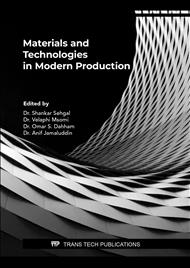[1]
A. Bakhtyari and M. Mofarahi, A New Approach in Predicting Gas Adsorption Isotherms and Isosteric Heats Based on Two-Dimensional Equations of State,, Arab. J. Sci. Eng., vol. 44, no. 6, p.5513–5526, 2019,.
DOI: 10.1007/s13369-019-03838-2
Google Scholar
[2]
V. G. Gude, N. Nirmalakhandan, S. Deng, and A. Maganti, Low temperature desalination using solar collectors augmented by thermal energy storage,, Appl. Energy, vol. 91, no. 1, p.466–474, 2012,.
DOI: 10.1016/j.apenergy.2011.10.018
Google Scholar
[3]
K. Thu, Y. D. Kim, M. W. Shahzad, J. Saththasivam, and K. C. Ng, Performance investigation of an advanced multi-effect adsorption desalination (MEAD) cycle,, Appl. Energy, vol. 159, p.469–477, 2015,.
DOI: 10.1016/j.apenergy.2015.09.035
Google Scholar
[4]
B. Rahimi and H. T. Chua, Low Grade Heat Driven Multi-Effect Distillation and Desalination, 1st ed. Elsivier Inc, (2017).
DOI: 10.1016/b978-0-12-805124-5.00002-4
Google Scholar
[5]
P. G. Youssef, S. M. Mahmoud, and R. K. AL-Dadah, Performance analysis of four bed adsorption water desalination/refrigeration system, comparison of AQSOA-Z02 to silica-gel,, Desalination, vol. 375, p.100–107, 2015,.
DOI: 10.1016/j.desal.2015.08.002
Google Scholar
[6]
W. Distribution, S. Moisture, and G. Ice, What is the big deal?,, SPC Water, Sanit. Hygen Water Distrib., vol. 2, p.2–3, (2020).
Google Scholar
[7]
D. B. Boman, D. C. Hoysall, D. G. Pahinkar, M. J. Ponkala, and S. Garimella, Screening of working pairs for adsorption heat pumps based on thermodynamic and transport characteristics,, Appl. Therm. Eng., vol. 123, p.422–434, 2017,.
DOI: 10.1016/j.applthermaleng.2017.04.153
Google Scholar
[8]
R. Wang, L. Wang, and J. Wu, ADSORPTION REFRIGERATION TECHNOLOGY THEORY AND APPLICATION,, John Wiley sons, p.526, (2014).
Google Scholar
[9]
K. C. Ng, K. Thu, Y. Kim, A. Chakraborty, and G. Amy, Adsorption desalination: An emerging low-cost thermal desalination method,, Desalination, vol. 308, p.161–179, 2013,.
DOI: 10.1016/j.desal.2012.07.030
Google Scholar
[10]
V. G. Gude, Exergy Evaluation of Desalination Processes,, 2018,.
Google Scholar
[11]
O. Alnajdi, Y. Wu, and J. K. Calautit, Toward a Sustainable Decentralized Water Supply : Review of Adsorption Desorption Desalination ( ADD ) and Current Technologies : Saudi Arabia ( SA ),, p.1–30, (2020).
DOI: 10.3390/w12041111
Google Scholar
[12]
F. Rouquerol, J. Rouquerol, K. S. W. Sing, P. Llewellyn, and G. Maurin, Adsorption by Powders and Porous Solids Principles, Methodology and Applications, 2nd ed. (2014).
DOI: 10.1016/b978-0-08-097035-6.00001-2
Google Scholar
[13]
J. N. Israelachvili, Intermolecular and surface forces, 3rd ed. Elisvier, (2011).
Google Scholar
[14]
M. Moshoeshoe, M. Silas Nadiye-Tabbiruka, and V. Obuseng, A Review of the Chemistry, Structure, Properties and Applications of Zeolites,, Am. J. Mater. Sci., vol. 2017, no. 5, p.196–221, 2017,.
Google Scholar
[15]
S. Ntsondwa, V. Msomi, M. Basitere, and Z. Mdletshe, The Comparative Analysis of Adsorbents Suitable for Thermal Desalination System,, 2019,.
Google Scholar
[16]
J. B. Condon, Surface Area and Porosity Determinations by Physisorption Measurements and Theory, 1st ed. Elsevier B.V., (2006).
Google Scholar
[17]
C. Tien, Introduction to Adsorption, Basics, Analysis, and Applications. Elsevier, (2019).
Google Scholar
[18]
Y. I. Aristov, Adsorptive transformation of heat: Principles of construction of adsorbents database,, Appl. Therm. Eng., vol. 42, p.18–24, Sep. 2012,.
DOI: 10.1016/j.applthermaleng.2011.02.024
Google Scholar
[19]
K. C. Ng et al., Experimental investigation of the silica gel-water adsorption isotherm characteristics,, Appl. Therm. Eng., vol. 21, p.1631–1642, 2001, [Online]. Available: www.elsevier.com/locate/apthermeng.
Google Scholar
[20]
R. P. Sah, B. Choudhury, and R. K. Das, A review on adsorption cooling systems with silica gel and carbon as adsorbents,, Renew. Sustain. Energy Rev., vol. 45, p.123–134, 2015,.
DOI: 10.1016/j.rser.2015.01.039
Google Scholar




